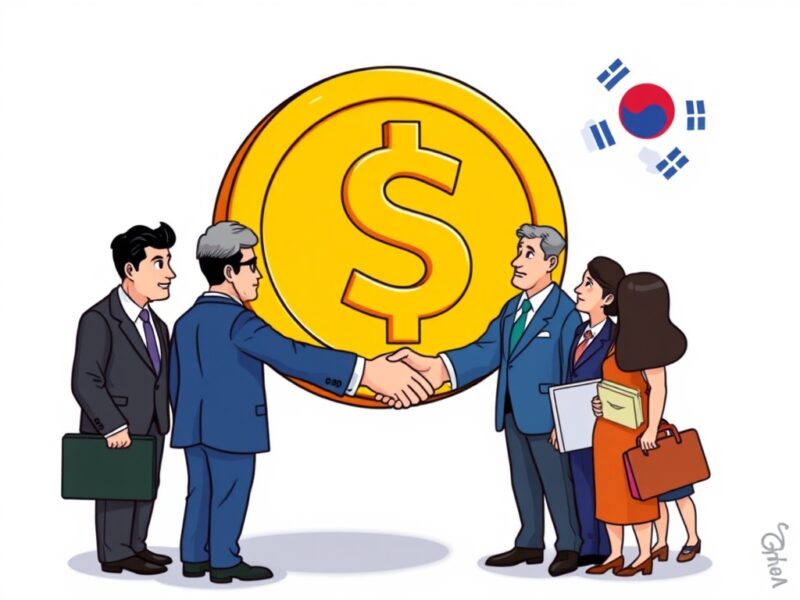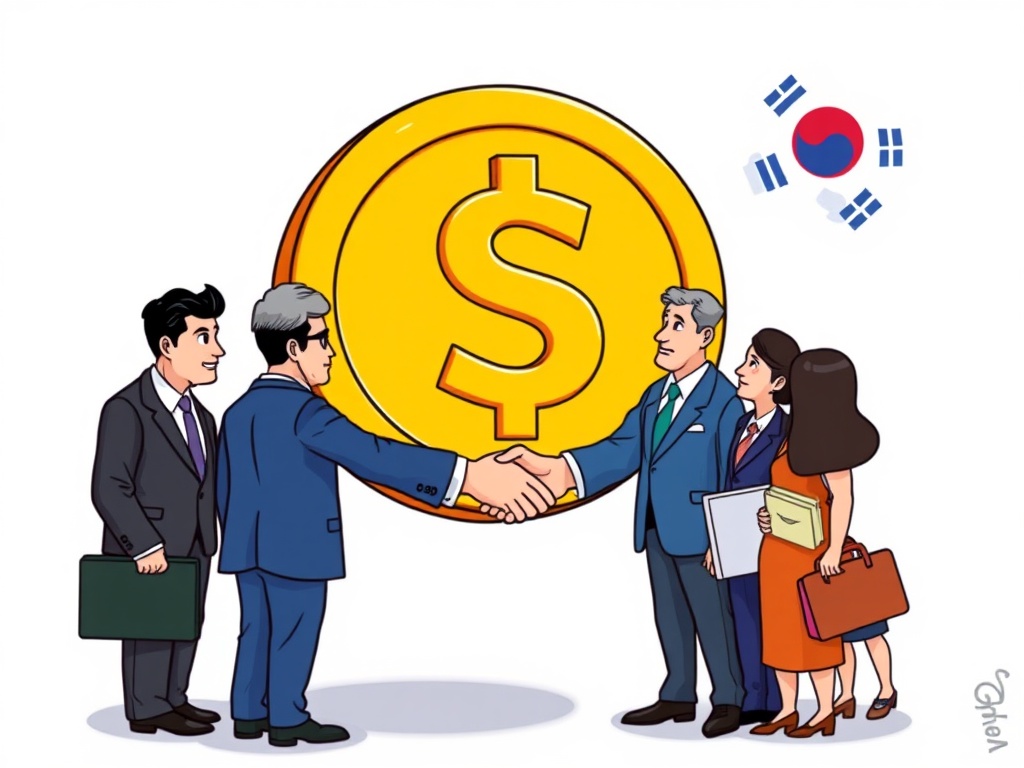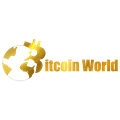Dollar Stablecoin Dominance: Circle’s Bold Partnership Proposal in South Korea
0
0

BitcoinWorld

Dollar Stablecoin Dominance: Circle’s Bold Partnership Proposal in South Korea
A significant development is unfolding in the world of digital finance, particularly concerning the future of global transactions. Circle, a leading financial technology firm, has made a compelling proposal to South Korea’s financial sector. They are seeking a partnership centered around their existing dollar stablecoin, notably expressing no interest in creating a won-pegged version. This strategic decision highlights Circle’s commitment to global interoperability and the power of the U.S. dollar in the digital realm.
Why Circle Prioritizes the Dollar Stablecoin in South Korea
During recent high-level meetings, Circle President Heath Tarbert engaged with key executives from four major South Korean financial groups. He clearly stated that Circle has no plans to collaborate on a won-denominated stablecoin. Instead, the focus was entirely on their established dollar stablecoin, USDC. This approach underscores a deliberate strategy.
What drives this decision? Circle believes in the universal utility of a globally recognized currency for digital transactions. Here are some key reasons:
- Global Liquidity: A dollar stablecoin like USDC offers unparalleled liquidity, making it ideal for international trade and cross-border payments.
- Stability and Trust: Pegged 1:1 to the U.S. dollar and fully reserved, USDC provides a reliable store of value and medium of exchange in the volatile crypto market.
- Existing Infrastructure: Circle has already built robust infrastructure around USDC, making it easier to integrate into existing financial systems worldwide.
This preference suggests a vision where the dollar stablecoin acts as a bridge, connecting diverse economies and financial ecosystems.
What Potential Benefits Could a Dollar Stablecoin Partnership Bring to South Korea?
For South Korean financial firms, partnering with Circle on its dollar stablecoin could unlock several opportunities. This isn’t just about adopting a new technology; it’s about embracing a new paradigm for international finance. Moreover, such a partnership could significantly enhance their capabilities in the digital asset space.
Consider these potential advantages:
- Enhanced Global Reach: South Korean businesses could facilitate smoother, faster, and cheaper international transactions using a globally accepted digital dollar.
- Innovation in Financial Products: Local firms might develop new services built on top of USDC, such as tokenized remittances, decentralized finance (DeFi) applications, or improved treasury management.
- Access to Global Capital Markets: A strong connection to the dollar stablecoin ecosystem could provide easier access to international capital and investment opportunities.
However, it’s also important to acknowledge potential challenges. Navigating regulatory frameworks and ensuring seamless integration with existing legacy systems will be crucial steps for successful adoption.
Understanding Circle’s Vision for Global Dollar Stablecoin Adoption
Circle’s proposal in South Korea is not an isolated event; it reflects a broader global strategy. The company aims to position USDC as the premier digital dollar, serving as a fundamental layer for the future of money and payments. Heath Tarbert’s discussions with South Korean executives are a testament to this ambition.
Circle envisions a world where a trusted dollar stablecoin streamlines financial operations across borders. This vision includes:
- Interoperability: Creating a seamless environment where digital assets can move freely and efficiently between different platforms and jurisdictions.
- Financial Inclusion: Providing access to stable, reliable digital currency for underserved populations globally.
- Programmable Money: Enabling new forms of financial innovation through smart contracts and automated transactions.
Indeed, this strategy aligns with the growing trend of digitalization in finance, where efficiency and accessibility are paramount.
The Future Impact of Dollar Stablecoin in Asian Markets
Circle’s focus on a dollar stablecoin partnership in South Korea sends a clear signal about the potential trajectory of digital finance in Asia. As economies become increasingly interconnected, the demand for efficient, stable, and globally recognized digital currencies will only grow. Therefore, other Asian nations might observe this development closely.
What does this mean for the wider region? It suggests a potential acceleration in the adoption of dollar-pegged digital assets for various uses, from trade finance to retail payments. Furthermore, it could influence how central banks and financial institutions in other countries approach their own digital currency strategies.
This bold move by Circle could truly reshape how South Korea, and potentially other Asian markets, interact with the global digital economy. It underscores the growing importance of a reliable dollar stablecoin as a cornerstone of modern financial infrastructure.
In conclusion, Circle’s steadfast commitment to its dollar-denominated stablecoin in its discussions with South Korean financial powerhouses is a significant indicator of its global strategy. By prioritizing a universally accepted digital dollar over a localized won-pegged alternative, Circle aims to foster greater interoperability, liquidity, and innovation within the region’s financial landscape. This initiative could pave the way for a more integrated and efficient global digital economy, with the dollar stablecoin playing a pivotal role.
Frequently Asked Questions About Circle’s Stablecoin Strategy
Q1: Why did Circle reject developing a won-pegged stablecoin for South Korea?
A1: Circle’s President Heath Tarbert indicated that the company is focusing on its existing dollar-denominated stablecoin, USDC, to promote global interoperability and leverage the U.S. dollar’s universal recognition and liquidity in digital finance.
Q2: What is a dollar stablecoin, and how does it work?
A2: A dollar stablecoin is a type of cryptocurrency designed to maintain a stable value, typically pegged 1:1 to the U.S. dollar. It achieves this by holding an equivalent amount of reserves (like cash and short-term U.S. government bonds) for every stablecoin issued, ensuring its value remains consistent.
Q3: What are the main benefits for South Korean financial firms partnering with Circle on its dollar stablecoin?
A3: Potential benefits include enhanced global reach for transactions, opportunities to innovate new financial products, and improved access to international capital markets, all facilitated by a globally recognized digital dollar.
Q4: How does Circle’s proposal align with its broader global strategy?
A4: Circle aims to establish USDC as the premier digital dollar, serving as a foundational layer for future money and payments worldwide. The South Korea proposal is part of this larger vision to foster interoperability, financial inclusion, and programmable money across various jurisdictions.
Q5: Will this partnership impact other Asian markets?
A5: While specifically targeting South Korea, Circle’s strategic focus on the dollar stablecoin could set a precedent and influence the adoption of dollar-pegged digital assets and digital currency strategies in other Asian countries.
Q6: Is Circle’s dollar stablecoin regulated?
A6: Yes, Circle’s dollar stablecoin, USDC, is fully reserved and regulated, undergoing regular attestations to ensure transparency and stability. This regulatory compliance is a key factor in its trustworthiness for financial institutions.
Did you find this insight into Circle’s strategic moves compelling? Share this article with your network on social media to spread awareness about the evolving landscape of global digital finance and the crucial role of the dollar stablecoin!
To learn more about the latest crypto market trends, explore our article on key developments shaping digital currencies institutional adoption.
This post Dollar Stablecoin Dominance: Circle’s Bold Partnership Proposal in South Korea first appeared on BitcoinWorld and is written by Editorial Team
0
0
 Manage all your crypto, NFT and DeFi from one place
Manage all your crypto, NFT and DeFi from one placeSecurely connect the portfolio you’re using to start.




